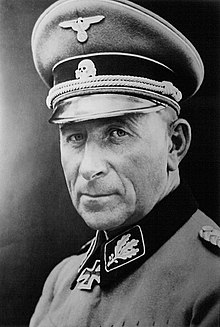Paul Hausser
| Paul Hausser | |
|---|---|

Paul Hausser as SS-Gruppenfuehrer
|
|
| Born |
7 October 1880 Brandenburg an der Havel, German Empire |
| Died | 21 December 1972 (aged 92) Ludwigsburg, West Germany |
| Buried at | Munich Waldfriedhof |
| Allegiance |
|
| Service/branch |
Prussian Army Reichsheer |
| Years of service | 1892–1932 1934–1945 |
| Rank |
Generalleutnant Oberst-Gruppenführer |
| Service number |
NSDAP #4,138,779 SS #239,795 |
| Commands held |
SS Division Das Reich II SS Panzer Corps Seventh Army |
| Battles/wars | |
| Awards | Knight's Cross of the Iron Cross with Oak Leaves and Swords |
| Other work | Founder of HIAG, Waffen-SS lobby group |
Paul Hausser (7 October 1880 – 21 December 1972) was a high-ranking commander in the Waffen-SS of Nazi Germany during World War II who played a key role in the post-war efforts by former members of the Waffen-SS to achieve historical and legal rehabilitation.
Hausser served an officer in the Prussian Army during World War I and attained the rank of general in the inter-war Reichsheer. After retirement, he joined the SS of Nazi Germany and was instrumental in forming the Waffen-SS. During World War II, he rose to the level of army group commander. He led Waffen-SS troops in the Third Battle of Kharkov, the Battle of Kursk and the Normandy Campaign.
After the war Hausser became a founding member and the first spokesperson of HIAG, a lobby group and a revisionist veterans' organisation, founded by former high-ranking Waffen-SS personnel in West Germany in 1951. It campaigned for the restoration of legal and economic rights of the Waffen-SS employing a multi-prong propaganda campaign to achieve its aims.
Hausser wrote two books, published by right-wing imprints, arguing the purely military role of the Waffen-SS and advancing the notion that its troops were "soldiers like any other", according to the title of the second book. Under Hausser's leadership, HIAG reshaped the image of the Waffen-SS as a so-called pan-European force that fought honorably and had no part in war crimes or Nazi atrocities. These ideas have since been discredited by historians.
Hausser was born on 7 October 1880 in Brandenburg an der Havel into a Prussian military family and entered the army in 1892. In 1899, he graduated from a cadet academy and was commissioned as a lieutenant in the 155th (7th West Prussian) Infantry Regiment. Hausser graduated from the Prussian Military Academy in Berlin in 1911. Hausser married Elisabeth Gerard in 1912; the couple had one daughter who was born in December 1913.
...
Wikipedia
